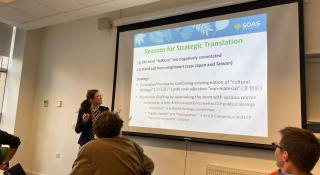
Breadcrumbs navigation
Performing civilisational narratives in East Asia: Asian values, multiple modernities, and the politics of economic development
Yong Wook Lee discusses the article published in the October 2020 issue of BISA journal Review of International Studies. The article aims to uncover the socially constructed normative foundation for the alternative East Asian economic development paradigm to neoliberalism in the context of civilisational politics.
One of the most enduring contributions English school writers have made to the field of International Relations is their studies of civilisational politics. In particular, the analyses of the standard of civilisation, which shed light on the impact of ‘the idea of progress’ on organising world politics, offer the conceptual and analytical tools to gain insight into the dialectical processes of domination and resistance between the West and the rest. The discourse and practice of the standard of civilisation can naturalise the temporal and sequential hierarchy of civilisational identities in world politics, while at the same time eliciting ‘the revolt against the West’. Civilisational domination and resistance are mutually constitutive of each other.
In this theoretical and empirical context, I focus my attention on the resistant side of civilisational politics. Since the late 1980s, East Asian states have promoted state-led economic development as a viable alternative to neoliberal market fundamentalism. Japan challenged the ‘Washington Consensus’ during this time. Southeast Asian leaders, including Dr Mahathir and Lee Kuan Yew, have heavily emphasised the positive role of the state, particularly in the early stages of economic development. China has recently become second to none in spreading worldwide its own experience of successful economic development, with the concept of a ‘Beijing Consensus’ a case in point. Arguably, the East Asian model has remained the most viable alternative over the last thirty years in the eyes of developing countries.
Against this backdrop, the question I seek to address in the article is why East Asian states make value claims (e.g. Asian values) when promoting their alternative method of economic development. The question is puzzling precisely because East Asian states could have done it without making value claims: pointing to their own enormous economic success would have been sufficient to justify their alternative development paradigm. As such, the challenge to the neoliberal doctrine is not simply about promoting a different method of economic development; it can be claimed that it constitutes a cultural revolt against the universalistic neoliberal assumption about how states and individuals within states should behave to promote economic development.
In addressing this question regarding Asian value claims in the context of challenging (neo)liberalism, I make two interrelated arguments. First, I argue that the politics of East Asian value claims can be understood as another case of non-Western society’s struggle to demonstrate multiple paths to modernity. An earlier form of this is found in the slogan ‘Japanese Spirit and Western Technology’ from Meiji Japan, which is founded on the concept of Ti Yong. Second, on a deeper level, I show that the narrative on Asian values (or ‘multiple modernities narrative’) is part of civilisation politics aimed to recalibrate the place of East Asia in a world consisting of the civilised and the uncivilised, a divide that still remains today in various forms following European expansion in the nineteenth century.
In developing the argument, I analytically draw on a combination of discursive/narrative analysis and performative theory of power. Central to this combinatorial theoretical insight is that the importance of narrative formation, reproduction, and reformulation hinges on their performative capacity not only to describe but also to engender empirical realities. As detailed below, this performativity is embedded in a narrative ontology in which the power of a narrative comes from its role in constituting (not just describing) the world as we know it. I empirically illustrate this theoretical insight by examining how East Asian value claims to economic success have historically been framed in the multiple modernities narrative. Here I utilise Eisenstadt’s (2000) concept of multiple modernities, which is defined as ‘multiple interpretations and responses to Western modernity’, to capture the core meaning structure of what underlined East Asian practices of linking local values to economic development in a civilisational context. I thus use multiple modernities as an interpretative concept. The validity of this analytical move is illuminated by considering that the ideas of civilisation and modernity have historically developed in East Asia as standing in a mutually constituting relationship. By associating local values with economic success, East Asian states not only describe why and how they succeeded economically, but also re-constitute the world of what is possible, what is natural, and what is normal for the economic development process. East Asian states’ claims for ‘multiple paths to economic development’ is an evaluative expression of multiple modernities that subverts the dominant neoliberal narratives and practices of a one-size-fits-all universal prescription. As such, the idea of multiple paths to economic development is repetitively, recurrently, and unmistakably observed in East Asian development narratives informed by civilisational politics.
In so doing, I aim to make two interrelated theoretical and empirical contributions to the existing literature on civilisational politics, whose analytical focus is to explore how historical actors (not analysts) make sense of and organise their international relations in civilisational terms. Theoretically, I newly shed light on a key underlying mechanism of production and reproduction of civilisational politics by drawing analytically on performative theory of power (‘constituting social reality by describing it’). To my best knowledge, no previous work has utilised this analytical potentiality in a fuller way for civilisational analysis. Empirically, I extend the scope of civilisational analysis by applying the nexus of modernity-civilisational politics to international economic relations and East Asia, both of which are relatively rare.
That said, Section II of the article (‘Narrative Power and Performativity’) sketches out the analytical framework of the article, which is a combinatorial analysis of discursive/narrative and performative power. This section also specifies how East Asian value claims can be empirically examined. The section begins with pointing out the problem of the conventional discourse analysis. The problem is the relative neglect of analyzing how discourse and narratives can intervene to bring out social reality because of its heavy analytical emphasis on the social construction of collective meaning in the past. The theory of performativity (‘construction of reality by describing it’), which is to explore the role of discourse and narratives in ‘making it happen’ rather than expressing something that is already there, is introduced to fill in this gap. The nexus of collective meaning and social action is thus established through the performativity mechanism of narrative, which brings out the mutually constitutive relationship of narrative description of and intervention in social reality. The power of narrative depends on the degree of its success in performativity. For example, there are multiple ways in which the concept of civilisation could be historically narrated. As discussed in Section III, however, when the concept of civilisation became closely associated with the idea of progress in the dominant Western narrative, it engendered a hierarchical, stage-based reality of relations among civilisations. As such, the idea of civilisation as progress in the dominant Western narrative has a conditioning relationship with the emergence and development of the multiple modernities-based value claims of Asian elites.
Section III (‘Civilisational Politics and Multiple Modernities in East Asia’) discusses in detail the analyses of civilisational politics by English school writers and historicises the rise of multiple modernities-based East Asian value claims in world politics. More concretely, it illuminates how the idea of progress, which is the central presumption of (Western) modernity, contributed to the ascendance of a Western narrative naturalizing a hierarchical understanding of civilisational relations, thus resulting in the notion of the standard of civilisation. The dominance of this Western narrative and its associated practices engendered the practice, idea, and narrative of multiple modernities in East Asia. But this section also shows that the dividing line between the civilised and the uncivilised is neither inevitable nor determined in its content and boundaries that constitute civilisational relations. In historicising East Asian value claims, this section highlights the dilemma virtually all East Asian states have faced since the European expansion in the late nineteenth century. That is, how much of what they considered to be their core values should be sacrificed to facilitate the import of modern projects, such as industrialisation and economic development linked to military modernisation?
One solution was the conceptualisation of this process in terms of selectively borrowing from the West in Ti-Yong. Ti denotes a given society’s imagined collective essence or identity, with Yong denoting the Western technology and institutions that might be used to defend the Ti. Earlier forms of this are found in the Chinese slogan ‘Preserving the Chinese essence and applying the Western technology’ and the Japanese one ‘Japanese Spirit and Western Technology’, used during the Meiji Restoration. This arguably constitutes an earlier effort on the part of East Asian states to establish a multiple-modernities project in East Asia, which anticipates East Asian value claims for its economic success in the late twentieth century and early twenty first century.
Section IV (‘Value Claims and Multiple Modernities in Economic Development Narratives’) empirically tracks the development and deployment of East Asian narratives on the relationship between economic development and values. The point of the empirical analysis here is two-fold. First, it identifies a range of value claims Asian elites have advanced to account for economic development in East Asia. Second, the analysis shows how these value claims have historically been constructed and deployed as counter-narratives to the dominant civilising force of (neo)liberalism in the world economy. This analytical effort is about historicising East Asian value claims synchronically and diachronically with the aim to reconstruct the core meaning structure that all narratives in some way assume, which is the idea of multiple modernities. It starts with debate over Asian values, and then moves onto a discussion of Japanese value claims. Finally, this section critically engages in the Chinese narratives of economic development at greater length to elucidate the performative aspect of multiple modernities behind the link between the concept of civilisation and the multiple development path narrative. China is selected because its current role and policies (e.g. the Belt and Road Initiative, the establishment of New Development Bank in the context of BRICs, and recipient-based ODA policies) most aggressively align with an alternative economic development paradigm. This section also notes that East Asian states indeed practice the idea of the multiple paths of economic development bilaterally and multilaterally through their ‘request-based’ ODA (Official Development Assistance) policy.
Section V (‘Conclusion’) outlines the implications of this research for the politics of civilisation and modernity in East Asia and beyond. At issue here is whether East Asia would overcome the Western modernity that underpins the hierarchical civilisational identities. On a closer inspection, two equally plausible, but paradoxical interpretations emerge out of the East Asian multiple modernities argument with respect to the ideas of hierarchy and progress. On the one hand, East Asian recalibrating can be interpreted in a transformative sense. As shown, for example, in Xi Jinping’s statement that ‘civilisations are only unique, no one is superior to the other’, this recalibrating is an East Asian strategic vision seeking to bring civilisational pluralism back in by upsetting the status quo; recalibrating (with local values and narratives) is open as well to all other civilisations.
On the other hand, the recalibrating can also lead to a re-centering East Asia in world politics. To put it differently, the recalibrating can be viewed as nothing but an epitome of a struggle for power to establish a new hierarchical order now centered on East Asia. As such, there are critical tensions between the two positional possibilities, and indeed the precise meaning of ‘what a recalibrated East Asia is and should be’. This has, since the late nineteenth century, continued to baffle Asian elites and scholars.
This section concludes by noting that there is indeed a possibility for East Asia to be the author of its own civilisational narrative based on a plural and pluralist perspective. But this possibility is conditioned on the continuing practice of reflexive awareness of why and how multiple modernities historically and politically matter to East Asia’s imagination of a better international society.
You can read the full article at DOI: https://doi.org/10.1017/S0260210520000212
BISA members receive access to RIS (and our other journal European Journal of International Security) as a benefit of membership. To gain access, log in to your BISA account and scroll down to the 'Membership benefits' section. If you're not yet a member join today.
Photo by Alex Knight on Unsplash


